“The new Dashew passagemaker draws much of its heritage from the high-performance sailboats for which the Dashews are well known…” –Bill Parlatore, Passagemaker Magazine

Of all the sailboats we’ve done over the years, Beowulf is our favorite. She was our ultimate couple’s cruiser, and the benchmark, against which we measured everything when we started down the FPB path. In seven years of cruising part time, see saw 40,000 nautical miles slip under her keel with just two on board.
The feeling she gave us at sea is not easily put into words. It was one of awesome, yet easily controlled, power. In just moderate winds, with the ocean barely white-capping, she’d do 300 miles a day. Bring the breeze up to moderate trade wind strength – 16 to 22 knots – and Beowulf would reward us with consistent 310- to 315-mile days. And this with the autopilot driving her. In fact, in the 40,000 miles we sailed her as a couple, the WH autopilot steered 100% of the time – offshore and in port. At 78 feet in length you would think she’d be a handful for the two of us. But of all the sailboats on which we’ve voyaged, Beowulf was the most easily managed (and comfortable) at sea, and well-behaved in port.

The photo above shows Beowulf lit up, reaching towards the Virgin Islands from Norfolk, Virginia. This was at the start of one of the two Caribbean 1500 races the two of us did with her (setting elapsed time records and winning on handicap both times). In 2014 as this is written, 14 years after the fact, those records, set by a couple in their dotage, still stand.

Here’s another view. Both of the code zero reaching jibs are rolled up on removable stays. These sails are easy to handle and provide enormous amounts of power. Note the canting bowsprit. Beowulf is such an apparent wind machine that she does not require spinnaker poles – even when jibing downwind. The canting bowsprit offset is just enough to keep the rig super-efficient at deep wind angles.
Beowulf is averaging 14 to 16 knots in this sequence of photos with the twin reachers. There is almost no bow wave at this speed, other than slop from the waves she is overtaking. That’s a sign of efficiency. The more efficient the hull, rig, and fins, the less work required by the crew to keep the boat moving. The combination of this efficiency, together with the flexibility of her ketch rig, allowed the two of us to comfortably maintain race boat level speeds, without a huge amount of effort or stress.

Here Beowulf is anchored near the 143-foot Philippe Brian designed ketch Mari Cha III. This is in 2000. In 1999, sailing in the Guadaloupe to Antigua race, Mari Cha lll set a record of three hours ten minutes for the 42 mile course. In 2000, Beowulf, with our son-in-law Todd Beveridge along for the ride, took five minutes off the record, winning on elapsed and corrected time. Conditions were ideal for us. The breeze was on the stern quarter at 16 to 18 knots and we planed all the way across..
In 2001, racing head to head with Mari Cha III, in close reaching winds, she put half an hour on us. However, we still easily won overall on handicap.
Beowulf in the Virgin Islands: she’s reaching at 10 knots, in about 8 knots of true wind (notice the white caps are just beginning to form).

Twice the fun with our two “cruising” chutes! This photo was taken off Auckland, New Zealand on a fresh fall day. We’re close-reaching, cruising along at 16 knots in about 19 knots of true wind speed. We would not normally sail this tight with the spinnakers offshore (we’re showing off for the helicopter photographer here).
All this speed made for comfortable, quick passages, such as Nuka Hiva in the Marquesas Islands to San Diego in 12 days, three hours (2900 miles), or Fiji to New Zealand in an easy four days (1100 miles). These kinds of averages allowed us to play the weather systems to our advantage.
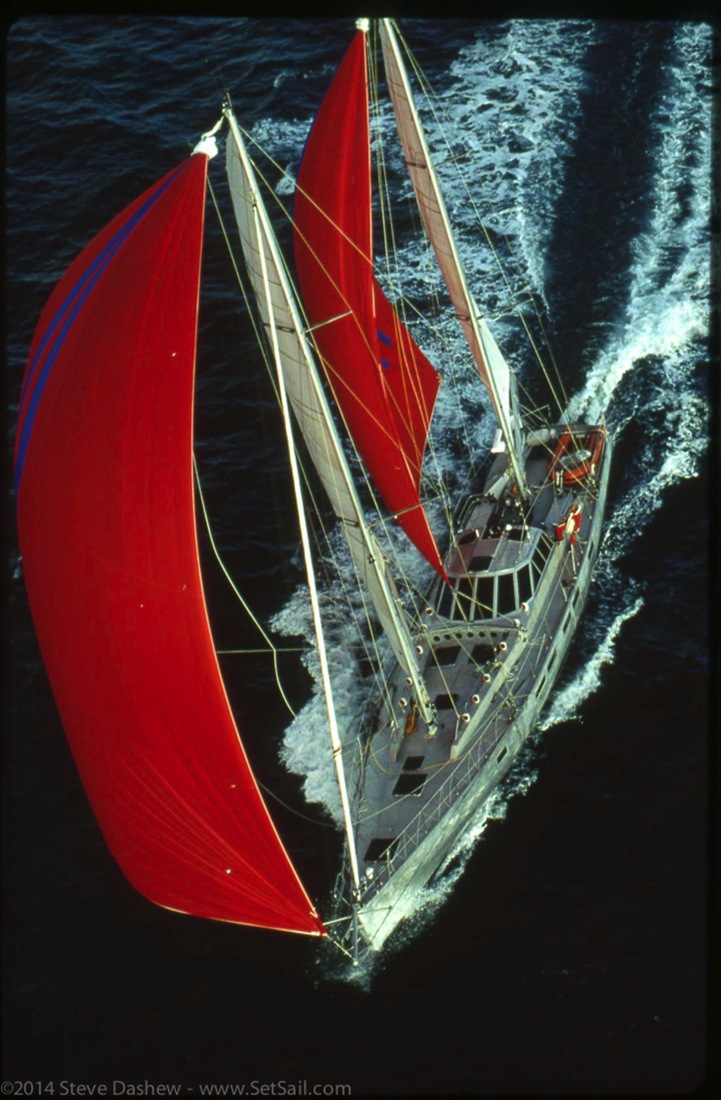
Later on and we’ve eased the sheets a hair. True wind angle is about 135 degrees. Apparent wind is forward of the beam, at about 75 degrees, and we’re still doing a steady 16 knots. Check out the wake and bow wave. Beowulf would sail for days on end set up like this (in the trades).

This photo was take during a lull in the wind. The breeze is down to about 14 knots, and Beowulf is sailing at about 13.

Of course not all cruising is downwind. Sailing to windward, Beowulf tacked through 95 degrees in smooth water (including leeway) and would average about 9 knots of boat speed in 12 to 14 knots of breeze while hard on the wind. In the open ocean, where we could crack off a few degrees, she’d sit on 10 to 10 1/2 knots through 16 to 18 knots of breeze, after which we’d start to slow her down as the seas began to build (for comfort).
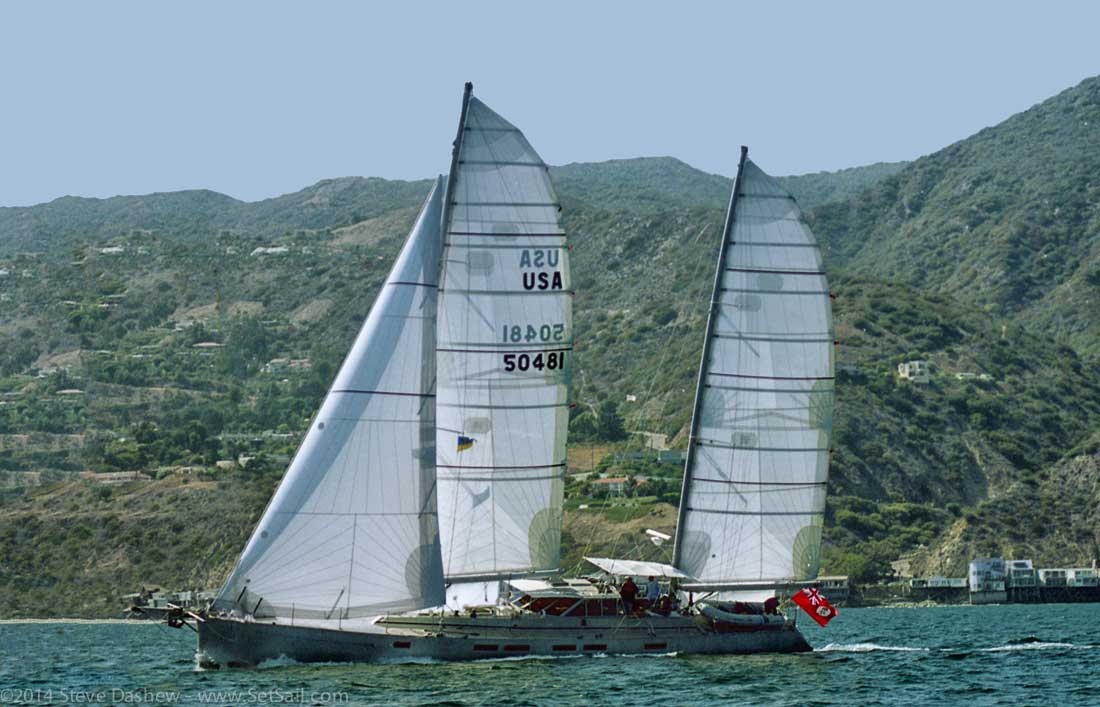
Notice the shape of the main and mizzen in these photos? Those beautiful elliptically tipped sails are made possible by the lack of backstays. Both main and mizzen masts were supported by 25-degree swept spreaders. This configuration allowed us to set these powerful sails on a very short rig.

If you saw Beowulf on the hook, you’d think someone forgot the upper third of the masts. Yet that short rig powered her along at a very nice clip. And these sails are easy to trim, raise, lower, and cover.
The sailing capabilities of Beowulf have been amply demonstrated by the passages she’s given us. But at the end of the day, at anchor, what kind of an ambiance did she provide during the 90% of the time she was at rest?

The pilot house on Beowulf was our nerve center. We spent many pleasant hours on watch in this cozy environment. All our electronics were close at hand, and we could keep an eye on the radar,

engine instruments, sailing instruments and charting computer from anywhere in the pilot house.

Immediately adjacent to the pilot house entrance are the main and mizzen sheet winches (which control 75% of the working sail area). These could be eased or trimmed while standing inside the pilot house.

The galley/saloon area is designed as a single “great room” with lots of visual space. The long hull windows give you a view of what’s going on outside, make the space feel even larger, and provide a lovely ambient level of lighting. There are a pair of 3-foot-square (0.9m) deck hatches to provide light and ventilation.

The galley (only partially shown above) provides a huge amount of work surface along with lots of easy-to-use storage.

Hull windows keep the galley crew in tune with what’s going on outside, at anchor and at sea. The area opposite the galley, on center, is a large fridge/freezer
and pantry storage area.
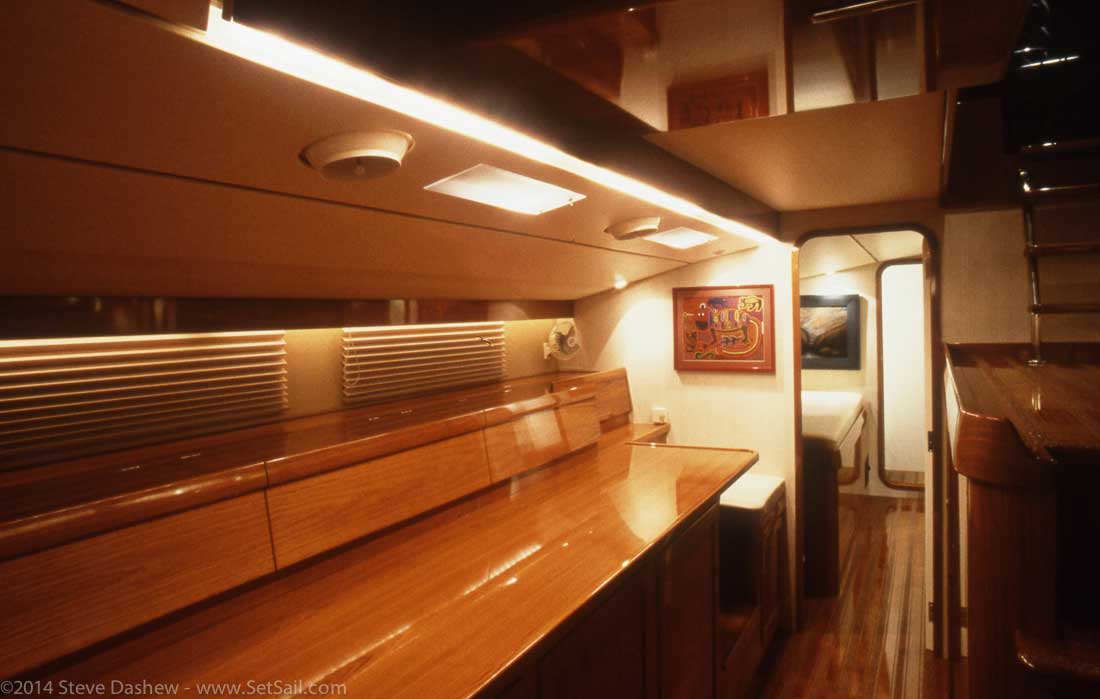
Opposite the galley is a large office area. You have the option of spreading things out while standing up, or working while seated from the aft end. Note the bin lockers on top of the counters (same as the galley) as well as the storage below counter level. The guest staterooms are aft. The companionway to the right of the photo leads to the pilot house. The top of the fridge/freezer provides the pilot house sole.

As with all of our designs, the owner’s suite is forward on Beowulf, where ventilation is best and we can hear the anchor if it is dragging. This view is looking aft, from the foot of the bunk. When the door to the saloon is open (which was most of the time for us) the stateroom and saloon spaces are joined visually, making for a very pleasant visual experience.
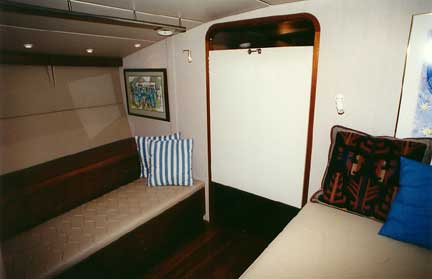
On those rare occasions when we had guests aboard, we could close the bi-fold door to secure our privacy. Note the gaps above and below the door. These allowed air flow between the saloon and the forward cabin.

On the starboard side of the hull there is a full-length settee, with a locker at the end. The head, with tub/shower, is just forward of the bulkhead with the artwork. This cabin is really hard to photograph, and these images do not do it justice, but they will give you some feel for the spaces.

Forward of the sleeping area is what we call the “dressing room”. This is a large space with vanities, lots of storage on open shelving, and our hanging locker.

The open shelving worked well for storage, kept everything in the open where it could breathe (no problems with mildew), and looked good (as long as everyone put their things away neatly!).

A combination washer/dryer is at the forward end of the dressing room.

The port guest stateroom shown above.
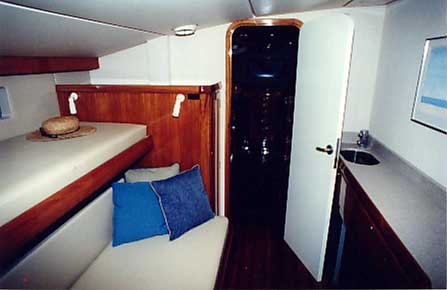
Here’s a slightly different angle. The vanity counter on the center was joined at the aft end by a tub/shower area (not shown).

Each stateroom has its own toilet compartment aft, with additional storage.

The starboard cabin has one double bunk.
Beowulf’s awning system, like that of the rest of our designs, was part of the original design criteria.

The cockpit, pilot house window, and forward deck awnings are usable at sea as well as in port.

The cockpit awning was always set, even in temperate climates (to keep off rain). The only time this was not in place was on passages in the higher latitudes, when we expected gales or storms.

The two awnings in the foreground cover the owner’s suite hatch and the saloon hatches. These work at anchor to force-feed even the lightest breezes below, keeping a good air flow going in the hottest climates. At sea, the saloon awning (shown raised at anchor while it acts as a wind catcher) was dropped down so as not to block our view from inside the pilot house. This awning system worked to keep the rain off the deck hatches, so that in most squalls, the hatches could be left open.

The cockpit area, immediately adjacent to the pilot house, allowed us to work the sails without having to go more than a few feet. All sailing controls were within 9 feet (2.7m) of the entrance to the pilot house.

The cockpit table, with its fold-up wings, provided a comfortable and convenient brace against which we could lean, or hang onto the rails mounted on top. We enjoyed many a pleasant meal at sea and at anchor in this area.

The mainsheet winch (powered) is to the right of the pilot house door. Both mainsail and traveler were controlled here. The primary winch is outboard (also powered). These were sized for kedging rather than sailing loads.

A variety of traveler positions, roller furling, and bowsprit angle controls are led through this bank of jammers. The same thing occurs on the port side. It looks complicated, but in reality is very simple to use.

We carried two dinghies on the aft deck. These were launched with the mizzen headsail halyards, led to one of the electric winches in the cockpit.

One of us could launch or retrieve a dinghy in less than two minutes. The halyard is led to the main sheet winch in the photo above. As a result, we almost always hauled the dinghies aboard at night, and rarely towed them when we were underway.

Hanavave Bay, on the island of Fatu Hiva, in the Marquesas. This is the most beautiful anchorage in the world.

Additional Resources
- You can sail aboard Beowulf, get a good feel for how easy she is to handle offshore, and take a tour of the engine room and interior with the one-hour DVD “Beowulf: the Legend Continues”. This DVD is a part of the 5-hour-long “Offshore Voyaging Series“
- Beowulf (and many of our other designs) are covered in detail in Offshore Cruising Encyclopedia. Additional information on her passages and handling will be found in Mariner’s Weather Handbook and Surviving the Storm.

Still with us? If so, you are hard core – but then, we are too. Following are some additional photos of the joinerwork details, hull shape, and engine room. The joinerwork photos which follow were all shot just before Beowulf went to her new owners. This is the original finish, 40,000 miles later.

We’re not big fans of teak unless it is “honey” teak. This material comes only from a few logs, typically out of Burma. In order to find material with this color and grain one needs to look through a huge quantity of raw material. And then you need to have the ability to spot it in the rough.

We mentioned earlier about the fridge/freezer box which divides the galley and office, and provides the sole for the pilot house. Note the walnut shell nonskid on the treads and cabin sole.

We’ve been using this nonskid system on our yachts for 25 years. It is very good when wet, and looks nice as well. Details on how to execute this will be found in our Offshore Cruising Encyclopedia.

This is the one of the corners of the forward bunk. Corners like this have to be carved, by hand, out of solid teak. The difficult part is knowing where to start the cut, so that the grain looks right – and matches the rest of the boat.

Here is another corner, this time of the aft starboard bunk intersection to the hanging locker.

Finally, a detail of the vanity counter in the forward dressing room. Notice how the fiddle rail is trimmed down in the way of the sink.

The headliner and hatch coaming system on Beowulf was a new approach for us. You probably noticed the architectural reveals between the panels. These look very nice, and promote the flow of air between the headliner panels and the deck. The hatch coamings are from solid timber. These are not easy to execute, but they look wonderful.

This is a detail of the carved notch where the Bomar cast hatch handles need to run when the hatches are dogged down.

This is a good shot of the headliner panels, their reveals, and how they intersect with the hatch coamings.

Handrails are laid out throughout the interior. There supports are bolted to hard spots which are integrated with the headliner supporting structure.

You are looking straight up here at one of the many Dorade vent “eyeballs”. These are large versions of the little air vents you are used to seeing on airliners. They allow us to aim and throttle the air flow.

We’ll end with a couple of photos of Beowulf out of the water. The hull shape has a minimum whetted surface configuration, commensurate with good initial stability. With full water ballast tanks, righting moments were on the order of 10,000 foot pounds, roughly comparable to a late IOR maxi yacht drawing 12 feet (3.7m).

It is hard to grasp how fine Beowulf‘s forward sections are. Conventional cruising boats have half entry angles on the order of 22 to 24 degrees. Most IOR maxi racers are down around 17 to 18 degrees. Beowulf‘s half entry angle is 11 degrees! This is one of the reasons she is so comfortable upwind under sail and power.

OK – we’ve run out of photos. If you’d like to learn more, there’s lots of information in our books and DVDs about Beowulf and the other boats we’ve built.





March 27th, 2014 at 3:46 pm
Beautiful vessel. After looking at the interior shots it’s very easy to see the “family” resemblance to Wind Horse.
March 27th, 2014 at 10:17 pm
Love the new pictures! I’ve probably read the post on Beowulf at least 20 times, and expect to keep reading it every few months. I think it’s somewhere on the site, but can’t find it now: how many sisterships were/are there? I know there’s at least one (blue hull, teak decks) that was advertised two or three years ago. Were there any others?
March 28th, 2014 at 1:13 am
Just two Beowulf claas yachts were built, Ward.
March 28th, 2014 at 5:49 am
As beautiful and powerful as she is, I am still amazed that your math suggests is is less expensive to cruise on the FPB platform. I guess although wind is free, equipment and maintenance to harness it are not!
Thank you for sharing again
Scott
March 28th, 2014 at 6:44 pm
Scott: You can buy a lot of miles worth of diesel for one of those thousand square foot mainsails!
March 29th, 2014 at 4:16 pm
I like that sleek pilothouse. I bet something similar would look fantastic atop the great room of an FPB.
March 31st, 2014 at 7:57 pm
Steve, with the large loose footed, full baton, mainsails what systems did you use to manage reelfng and mainsail storage with just the two of you? Thanks in advance.
April 1st, 2014 at 8:47 am
Hi David:
Reefing on Beowulf was first a matter of rolling the jib away (25% of area) as she balanced nicely bare headed. Next we’d drop the mizzen. Main only we were good for 50 knots. If we were going to be shortened down for a long haul we’d put a deep reef in main and mizzen. This was a slab reefing setup – nothing fancy – with a pair of stainless ears to contain the sail which also were used for a neat furl. Reefing was a single person job took three minutes.
April 4th, 2014 at 3:21 pm
[…] To Steve Dashew over at Setsail for the photo of Beowulf. […]
April 27th, 2014 at 10:21 pm
Hi Steve,
Perhaps you may answer a few questions for me?
I see the hull is painted? If so,what do you use for this?
What are the actual mast heights? Couldn’t find this data.
Additionally,the prop diameter/pitch?
In all events,Beowulf is wonderful history for the art and science !
Thank you both for something special!
Oh,curiously I happened to hear your daughter,Sarahs’ music-a poet and voice-rare.
Best Regards,Arthur
April 29th, 2014 at 1:29 pm
Hi Arthur:
Beowulf’s hull is bare aluminum, except for the bootstripe and bottom paint area. From memory the prop was 26″, and it is a Hundested CP, so pitch is variable. Rig height was about 70 feeton the main and a little less on the mizzen. Main was about 980 square feet, mizzen about 10% smaller.
April 29th, 2014 at 11:36 am
Hey Steve I have a question on what size autopilot you used for the 60 – 80 footer. I went cruising in a 45 for 5 years
used the ray marine largest they had and it was really too small in winds of 25 knots. Can you guide me to the larger
autopilots you have experience with. Thanks , John Ward ex sv little mermaid.
April 29th, 2014 at 2:40 pm
Re autopilot size, we always fit oversized pilots so we have extra muscle for heavy weather. On the 64s 1/4HP or less will do the job most of the time, but we would fit 1/2HP for the extra margin. However, we are pushing around hulls which are very easily steered, with counterbalanced rudders, going quite fast in ocean crossing motorboat terms. So take care with extrapolating what we do to other yachts.
May 3rd, 2014 at 10:51 pm
The boat looks great and incredibly clean (mine was never even close). I was interested to see more of a work/spare parts area.
Why the inflatable? I did not have any luck with them. Wouldn’t an aluminum Sea Jay or Nomad match the exterior?
May 4th, 2014 at 11:31 am
We’ve had very good luck over the years with various AB aluminum bottom RIBS.
June 7th, 2014 at 4:05 pm
What is the best way to protect this huge hull from galvanic corrosion. Is it epoxy tar I see? What about the inside of the hull? How to get access?
Can the hull, with very few frames and stringers, take on a full scale killer whale attack, 30 knots, combined with your boat speed?
Having in mind the building costs, have you by any chance designed something smaller? For example
a 45 foot ketch rigged cutter.
June 13th, 2014 at 10:54 am
Lots of questions, most of which you will find the answers to by searching SetSail. Re plans, we only do completed yachts.
August 28th, 2014 at 11:04 pm
Hi Steve
Had the pleasure of seeing Beowulf’s sister in Victoria BC harbour awhile back, also there is a FPB 64 in Sidney. Love the sight and your yachts.
Would you build another sailboat if asked?
August 30th, 2014 at 1:14 am
Hi Doug:
Thanks for the comments. Re building another sailboat, it would be great fun if we had the bandwidth, but the reality is that we do not. So, we’d have to say no to another sailboat project, as much as this pains us.
April 24th, 2015 at 6:57 am
Hi,
Do you, or Kelly Archer still make beowulf class yachts?
April 26th, 2015 at 5:38 pm
No, those are long in the past.